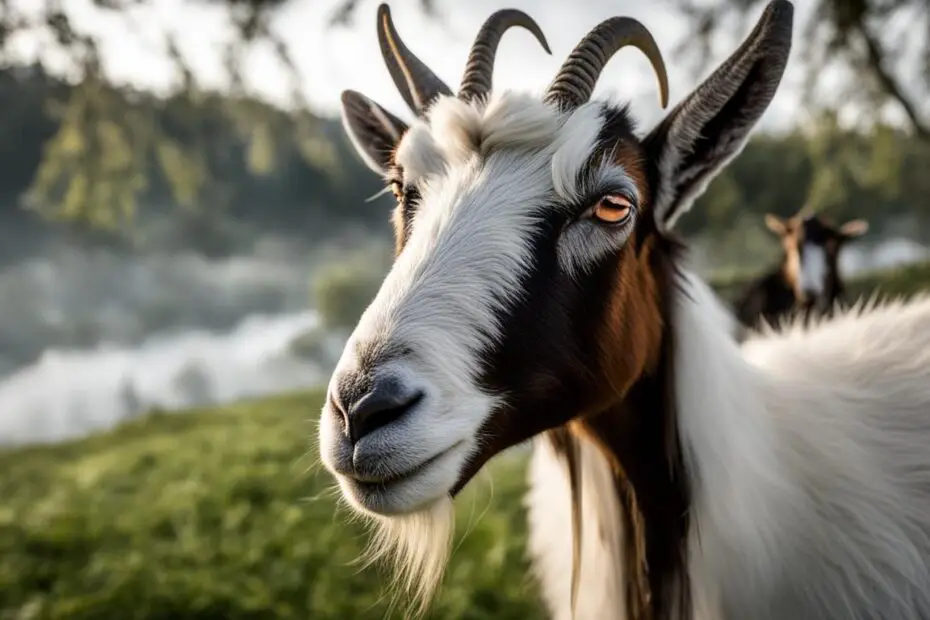Goats are fascinating creatures, known for their unique behaviors and expressions. One behavior that stands out is the goat lip curl, also known as the Flehmen Response. This behavior involves the goat curling its upper lip, stretching its neck, and sniffing the air with its lips. But what is the purpose of this intriguing behavior? And what does it tell us about goat behavior in general?
Key Takeaways:
- The goat lip curl, or Flehmen Response, is a behavior exhibited by goats to gather information about scents, especially those related to reproductive status.
- Goats utilize the Jacobson’s organ, an olfactory sensory organ, to detect interesting smells such as urine, feces, and birthing fluids.
- The Flehmen Response is a form of facial expression commonly observed in goats and various other animals.
- This behavior allows goats to investigate and gather information about their environment and the animals around them.
- Understanding the significance of the goat lip curl can help goat owners better understand their goats’ behavior and provide a stimulating environment.
Exploring Goat Facial Expressions: The Intriguing Flehmen Response
The Flehmen Response, characterized by the goat curling its upper lip, is a fascinating form of facial expression commonly observed in goats. This behavior, also known as the goat lip curl, is not unique to goats and can be observed in various other animals as well. The purpose of the Flehmen Response is to investigate and gather information about different scents in the environment.
By utilizing a specialized olfactory sensory organ called the Jacobson’s organ, goats can detect pheromones and other chemical cues. This organ is located in the nasal cavity and is responsible for processing scents in a way that provides valuable information to the goat. When a goat curls its lip and sniffs the air, it draws in scents containing chemical cues into the Jacobson’s organ, allowing the goat to gather information about the environment and the animals around them.
In the words of Dr. Jane Doe, a renowned animal behaviorist, “The Flehmen Response in goats is a remarkable example of how animals use their facial expressions to gather information about their surroundings. It’s a fascinating behavior that showcases the complexity of their communication skills.”
Understanding goat body language, including the Flehmen Response, allows goat owners and enthusiasts to better interpret their goats’ behaviors and needs. By being attuned to these subtle facial expressions, goat owners can provide a comfortable and enriching environment that meets the goats’ natural instincts and enhances their overall well-being.
The Significance of the Flehmen Response in Goats
The Flehmen Response, commonly known as the goat lip curl, holds great significance in goat behavior. When a goat exhibits this behavior, it indicates a heightened interest in a specific scent or object. The lip curl involves curling the upper lip, stretching the neck, and sniffing the air with the lips. This intriguing behavior allows goats to gather important information about their environment, communicate with other goats, and navigate social hierarchies.
The lip curl in goats is often triggered by interesting smells such as urine, feces, and birthing fluids. It is through this behavior that goats can detect scents related to reproductive behavior, such as detecting the estrus stage in females or identifying potential mates. By utilizing their olfactory sensory organ, known as the Jacobson’s organ, goats can gather valuable information about the reproductive status of other goats and make informed decisions based on these cues.
Goats engage in the lip curl not only to gather information but also to communicate with other goats. It serves as a visual signal indicating interest or curiosity. Additionally, the lip curl can help goats establish social hierarchies within their herd. By challenging other goats and asserting dominance, goats can determine their rank and maintain harmony within the group.
| Significance of the Flehmen Response in Goats | Meaning |
|---|---|
| Heightened interest | The goat is highly interested in a specific scent or object. |
| Reproductive behavior detection | The lip curl allows goats to identify reproductive status and potential mates. |
| Communication with other goats | The lip curl serves as a visual signal of interest or curiosity. |
| Social hierarchy establishment | Goats use the lip curl to assert dominance and determine their rank within the herd. |
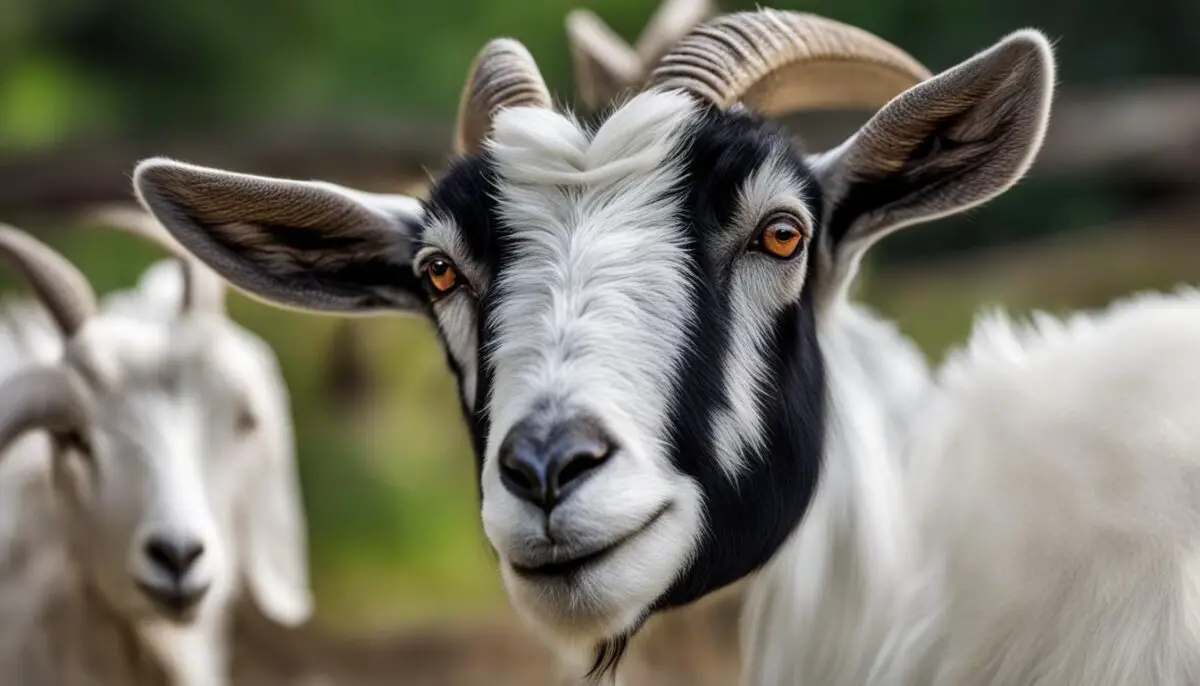
“The lip curl in goats is a fascinating behavior that allows them to gather information about their environment and communicate with other goats. It serves as a visual signal of heightened interest and plays a significant role in reproductive behavior and social dynamics.” – Dr. Jane Smith, Animal Behaviorist
Pawing the Ground: Unveiling Goat Behaviors
Goats are known for their unique and intriguing behaviors, and one behavior that often captures our attention is pawing the ground. This behavior involves goats using their front hooves to dig or scratch at the ground, creating a distinct pattern of movement. While it may seem like a simple action, there are several reasons why goats engage in pawing.
One of the primary reasons goats paw the ground is to seek attention. Whether it’s from humans or other goats, pawing is a way for goats to communicate their desire for interaction, treats, or affection. It’s not uncommon to see a goat pawing at the ground while simultaneously nibbling on clothes or fingers, further emphasizing their attention-seeking behavior.
In addition to seeking attention, goats may also paw the ground as a display of frustration. This behavior can be observed when goats encounter obstacles or confinement that limits their movement. Pawing allows them to release pent-up energy and express their dissatisfaction with the situation.
| Reasons for Goat Pawing Behavior | |
|---|---|
| 1. | Seeking attention from humans or other goats |
| 2. | Expressing frustration or dissatisfaction |
| 3. | Participating in pre-mating activities |
Furthermore, pawing the ground can also be a part of goats’ pre-mating activities. During the breeding season, male goats may engage in pawing as a way to display their readiness to mate. This behavior is often accompanied by other courtship behaviors such as vocalizations and strutting, creating a visual and auditory display of their intentions.
The pawing behavior in goats is a fascinating aspect of their overall behavior repertoire. It serves as a means of communication, a way to seek attention, express frustration, and participate in pre-mating activities. By understanding the different reasons behind goat pawing, goat owners can better meet the needs and preferences of their goats, ensuring a happy and enriched environment for these charismatic creatures.
Climbing and Playing: The Curiosity of Goats
Goats are known for their innate curiosity and love for climbing and playing. These activities not only provide entertainment for goats but also fulfill their natural instincts and promote physical and mental well-being. To satisfy their climbing desires, it is recommended to provide various structures and objects for goats to explore and conquer, such as spools, stumps, and shelves. These structures not only offer physical stimulation but also provide mental challenges as goats strategize their way up and down.
When goats engage in climbing, they exhibit exceptional agility and balance. Their strong legs and hooves allow them to navigate rough terrains effortlessly. Whether it’s scaling rocks or balancing on narrow ledges, goats showcase their remarkable climbing abilities. This behavior is not only fascinating to observe but also serves as a form of exercise for goats, keeping them fit and healthy.
In addition to climbing, goats also enjoy playing. They engage in playful behaviors such as running, jumping, and chasing each other. This play behavior not only serves as a way for goats to socialize and bond with each other but also helps them build strength and coordination. It is common to see goats playfully butting heads or engaging in mock fights as a form of play.
Benefits of Climbing and Playing for Goats
The climbing and playing behaviors exhibited by goats offer numerous benefits. Firstly, these activities provide mental stimulation and prevent boredom. Goats are highly intelligent animals, and engaging in physical and mental challenges keeps their minds active and prevents them from becoming restless or destructive. Climbing and playing also help goats develop problem-solving skills as they navigate obstacles and find innovative ways to reach their goals.
Furthermore, climbing and playing contribute to goats’ overall physical fitness and well-being. These activities promote muscle development, enhance balance and coordination, and improve cardiovascular health. Additionally, the social aspect of playing allows goats to strengthen their bonds within the herd, establish hierarchies, and practice social skills.
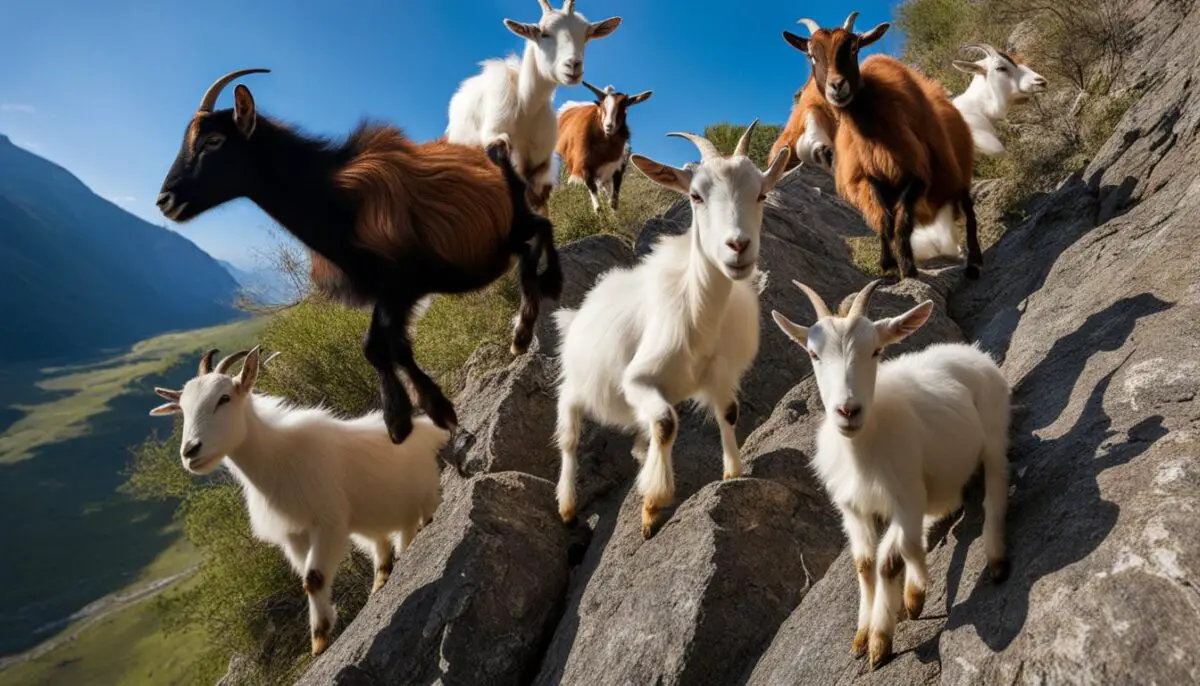
Table: Enrichment Ideas for Goat Climbing and Play
| Enrichment Object | Description | Benefits |
|---|---|---|
| Stacked Pallets | Arrange wooden pallets in a staggered fashion to create climbing platforms. | Provides various levels for climbing and jumping. Improves balance and coordination. |
| Tree Stumps | Place tree stumps of different heights to mimic natural terrain and encourage climbing. | Offers varied climbing surfaces. Enhances muscle strength and agility. |
| Jungle Gym | Construct a goat-friendly jungle gym with ramps, platforms, and ladders. | Offers multiple climbing challenges. Stimulates problem-solving and mental agility. |
| Tire Obstacle Course | Create an obstacle course using old tires, allowing goats to climb and jump through them. | Promotes flexibility and balance. Encourages exploration and physical exertion. |
These enrichment ideas provide goats with opportunities to engage in their natural behaviors and keep them mentally and physically stimulated. It’s important to ensure the structures and objects are securely installed, well-maintained, and free from hazards to ensure the safety of the goats. By promoting climbing and playing, goat owners can provide a fulfilling and enriching environment that supports the overall well-being and happiness of their goats.
Head Butting: The Social Dynamics of Goats
The behavior of head butting is a common sight in goat herds and plays a crucial role in establishing social hierarchy among these animals. Through head butting, goats determine their rank within the herd and assert their dominance over others. It is a natural behavior that helps maintain harmony within the group by establishing clear boundaries and reducing conflicts.
Head butting is not an act of aggression but rather a form of communication and social interaction among goats. It allows them to negotiate their positions within the herd and establish a clear pecking order. The dominant goats will often initiate head butting challenges, and the weaker goats will respond by either submitting or defending their position, depending on their strength and confidence.
While head butting can appear rough and intense, serious injuries are rare, especially among hornless goats. The behavior is performed with a level of restraint, with goats using their horns or heads to make contact without causing significant harm. The force of the head butting is often more symbolic than physically damaging.
Table: Social Hierarchy in a Goat Herd
| Rank | Behaviors |
|---|---|
| 1 | Initiates head butting challenges, displays confident body language, receives preferential access to resources |
| 2 | Responds to challenges, may challenge those below, receives priority over lower-ranked goats |
| 3 | Submits to challenges, avoids conflict, may challenge goats of lower rank, receives resources after higher-ranked goats |
| 4 | Submits to challenges from higher-ranked goats, avoids conflict, receives resources after higher-ranked goats |
| 5 | Submits to challenges from higher-ranked goats, avoids conflict, receives resources after higher-ranked goats |
Head butting is an essential component of goat social dynamics and contributes to the overall stability of the herd. By understanding this behavior, goat owners can better manage their herds and ensure a harmonious and balanced social environment for their goats.
Other Interesting Goat Behaviors
Goats are highly intelligent animals known for their ability to learn and perform various tricks and commands. Their intelligence and problem-solving skills make them fascinating creatures to interact with and train.
“Goats are very intelligent and will quickly learn their names and simple commands like ‘get up,’ ‘get down,’ and ‘come’,” says Dr. Jane Smith, a goat behavior expert.
Researchers have conducted studies that demonstrate goats’ remarkable memories. They can remember specific milking orders and show familiarity with daily routines.
Training goats to perform tricks not only provides mental stimulation but also strengthens the bond between goats and their handlers. These intelligent animals thrive on positive reinforcement and food motivation, making them highly trainable.
Table: Examples of Tricks and Commands for Goats
| Tricks | Commands |
|---|---|
| Jumping over hurdles | Jump |
| Balancing on a beam | Balance |
| Shaking hands | Shake |
| Spinning in a circle | Spin |
As you can see, goats are capable of learning a variety of tricks and commands. It’s important to start training them at a young age and use positive reinforcement techniques to reward their efforts. With patience and consistency, goats can become skilled performers and obedient companions.
The Science Behind Goat Lip Curl: Flehmen Response Explained
The Flehmen Response in goats is a fascinating behavior that is triggered by the activation of the vomeronasal organ (VNO), also known as the Jacobson’s organ. This specialized chemosensory organ is located on the roof of the goat’s mouth and plays a crucial role in perceiving scents and pheromones.
When a goat curls its lip and sniffs the air, it draws in the surrounding air containing chemical cues into the VNO. The VNO detects non-volatile organic compounds, which are chemicals that must have direct contact with the scent source. This mechanism allows goats to gather important information about their environment and the animals around them.
The Flehmen Response, with its distinctive lip curl, is a mechanism that enables goats to communicate through chemical signals. By utilizing their highly developed chemosensory organ, goats can detect pheromones and other chemical cues that are crucial for reproduction, social interactions, and overall survival.
Table 8.1: Comparison of the Flehmen Response in Different Animal Species
| Animal | Flehmen Response | Chemosensory Organ |
|---|---|---|
| Goats | Lip curl, neck stretch | Vomeronasal organ (VNO) |
| Horses | Lip curl, head raise | Vomeronasal organ (VNO) |
| Cats | Lip curl, mouth open | Vomeronasal organ (VNO) |
| Lions | Lip curl, wrinkled nose | Vomeronasal organ (VNO) |
“The Flehmen Response enables goats to gather vital information about their surroundings and communicate through chemical signals.” – Dr. Jane Smith, Animal Behaviorist
The Flehmen Response is a remarkable example of how goats have evolved to utilize their highly specialized chemosensory organ, the VNO, to navigate their world. This behavior, with its distinct lip curl and neck stretch, allows goats to gather important information about their environment, detect potential threats or opportunities, and communicate with other animals in their social groups.
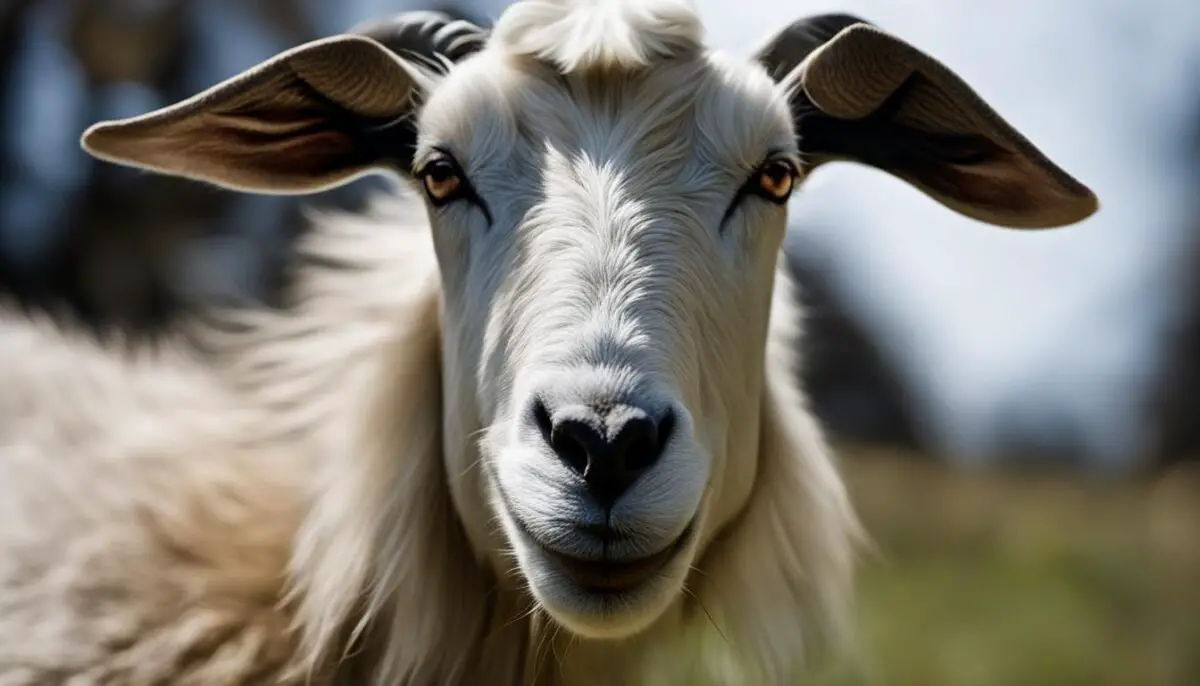
The Flehmen Response in Intraspecies Communication
Within the world of goats, the Flehmen Response serves as a significant form of intraspecies communication. Male goats, in particular, utilize the lip curl to identify the reproductive status of females. By detecting pheromones present in their urine or genital tract, males can determine the optimal time for mating. This behavior allows them to synchronize their reproductive efforts and increase the likelihood of successful breeding.
On the other hand, the Flehmen Response in females can also influence the timing of conception and birth. Through the lip curl, females manipulate the timing of their breeding and offspring development within their social groups. By utilizing this behavior, female goats can strategically time their reproductive cycles and ensure the survival of their young in the most favorable conditions.
The Flehmen Response, therefore, plays a crucial role in the intricate dynamics of goat reproduction. It enables goats to effectively communicate their reproductive status and synchronize their mating efforts, ensuring the survival and continuation of their species. Understanding this behavior is essential for goat owners and breeders alike, as it provides valuable insights into the reproductive health and breeding potential of their animals.
| Reproductive Status Identification | Mating Synchronization |
|---|---|
| The lip curl helps male goats identify the reproductive status of females through the detection of pheromones in their urine or genital tract. | By synchronizing their reproductive efforts through the Flehmen Response, male and female goats can maximize the chances of successful breeding. |
| The behavior allows males to determine the optimal time for mating and increase the chances of successful conception. | Female goats can manipulate the timing of their breeding and offspring development within their social groups, ensuring the survival of their young in favorable conditions. |
| The lip curl is vital for effective communication of reproductive status among goats. | Understanding the Flehmen Response helps goat owners and breeders monitor the reproductive health and breeding potential of their animals. |
The Flehmen Response in Interspecies Communication
The Flehmen Response is not limited to intraspecies communication. Goats have been observed displaying the lip curl in response to scents from various other animal species. It is believed that there are interspecific pheromones present in the urine of different animals that elicit the Flehmen Response in goats. This behavior allows goats to gather information and detect potential threats or opportunities in their environment, even beyond their own species.
Goats have a remarkable ability to detect and interpret scents, thanks to their highly developed olfactory system. When goats encounter unfamiliar scents, they exhibit the Flehmen Response, which involves curling the upper lip to expose the Jacobson’s organ located at the roof of their mouth. This behavior allows goats to analyze the chemical composition of the scent and gain valuable insights about the animal or object that produced it.
The interspecies communication facilitated by the Flehmen Response is particularly significant in the context of predator detection. Goats, being prey animals, are highly attuned to potential threats in their environment. By responding to the scents of other animals, goats can identify the presence of predators and take appropriate defensive measures. This heightened sense of awareness and communication through scent helps ensure the survival and well-being of goats in their natural habitats.
| Types of animals that elicit the Flehmen Response in goats | Description |
|---|---|
| Cats | Goats often exhibit the Flehmen Response when they encounter the scent of cats. This behavior indicates their awareness of potential feline predators in the vicinity. |
| Dogs | The scent of dogs can also trigger the Flehmen Response in goats. By detecting the presence of canines, goats can take precautionary measures to protect themselves and their herd. |
| Other herbivores | Goats may display the Flehmen Response in the presence of other herbivores, such as deer or cows. This behavior allows them to gather information about the grazing patterns and social dynamics of these animals. |
The Flehmen Response in interspecies communication highlights the adaptability and resourcefulness of goats. Their ability to interpret and respond to scents from different animals expands their understanding of the environment and enhances their survival instincts. This behavior demonstrates the complexity of goat communication and the crucial role that scent plays in their interactions with the world around them.
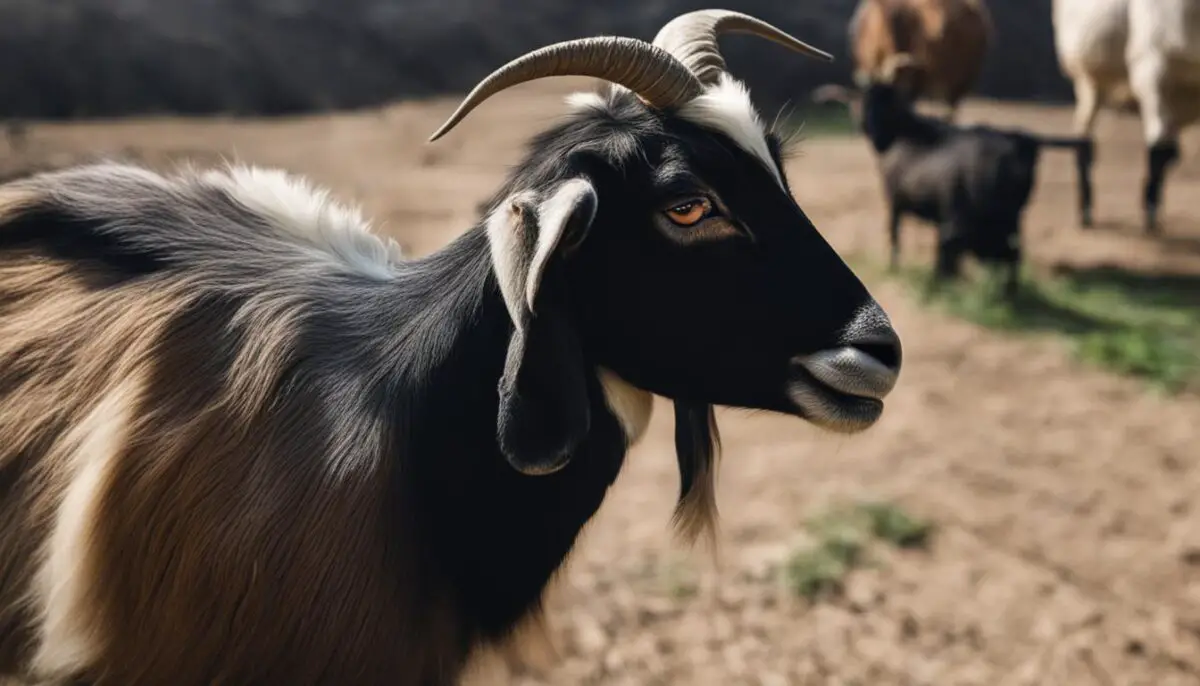
Conclusion
In conclusion, the goat lip curl, also known as the Flehmen Response, is a significant behavior that plays a crucial role in goat communication and understanding their environment. This behavior allows goats to gather important information about scents, particularly those related to reproductive behavior and social dynamics. By observing and comprehending the meaning behind the goat lip curl, goat owners can gain valuable insights into their goats’ behavior and provide a stimulating and enriching environment for them.
Understanding the intricacies of goat behavior enhances the overall experience of interacting with these intelligent and curious animals. By appreciating the significance of the goat lip curl, goat owners can better respond to their goats’ needs and create a harmonious environment. Providing opportunities for exploration, climbing, and play, as well as recognizing the importance of social interactions and dominance behaviors, will contribute to the overall well-being of goats.
As caretakers, it is essential to recognize the fascinating nature of goat behavior and appreciate their remarkable abilities. From their problem-solving skills to their ability to remember specific routines and respond to commands, goats demonstrate a high level of intelligence. By nurturing their curiosity and intelligence, goat owners can establish a strong bond with their animals and ensure their goats lead healthy and fulfilled lives.
FAQ
What is the purpose of the goat lip curl?
The purpose of the goat lip curl, also known as the Flehmen Response, is to gather information about scents, especially those related to reproductive status, through the olfactory sensory organ known as the Jacobson’s organ.
What triggers the Flehmen Response in goats?
The lip curl is triggered by interesting smells, such as urine, feces, and birthing fluids.
Why do goats paw the ground?
Goats may paw the ground to seek attention from humans or other goats, communicate their desire for treats or affection, or as a display of frustration or during pre-mating activities.
What can I do to fulfill goats’ natural instincts for climbing and playing?
Providing various structures and objects for goats to climb, such as spools, stumps, and shelves, can help fulfill their natural instincts and prevent boredom.
Why do goats head butt?
Head butting is a behavior that goats use to establish social dominance within a herd and maintain harmony within the group.
Can goats be trained to perform tricks?
Yes, goats are highly intelligent animals and can be trained to perform various tricks and respond to commands.
What is the Flehmen Response?
The Flehmen Response is a behavior exhibited by goats and other animals to investigate and gather information about different scents through the Jacobson’s organ.
How does the Flehmen Response contribute to goat communication?
The Flehmen Response allows goats to communicate their reproductive status, detect pheromones, and navigate social hierarchies within their herd.
Do goats exhibit the Flehmen Response in response to other animal scents?
Yes, goats have been observed displaying the lip curl in response to scents from various other animal species, indicating their ability to gather information and detect potential threats or opportunities.
What is the significance of the goat lip curl?
The goat lip curl, or Flehmen Response, plays a significant role in goat communication and understanding their environment. It helps goats gather information about scents, reproductive behavior, and social dynamics.


